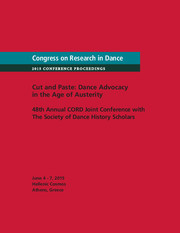No CrossRef data available.
Article contents
Inscribing/Inscribed: Bodies and Landscape in the Ritual of Embodied Remembrance at Souvenance Mystique
Published online by Cambridge University Press: 17 September 2015
Abstract
There are many ways in which Haitian Vodou ceremonies defy Western binaries of ritual and performance, sacred and profane, and choreography and improvisation. Vodou, a danced religion, is an embodied practice. Souvenance Mystique refers to a place and an event. Eponymously named, it is a mystical remembrance that occurs annually in a weeklong ritual of Vodou ceremonies in the Artibonite Valley outside of Gonaives, Haiti. At Souvenance, the reference to memory and remembrance is embodied, and therefore Souvenance greatly reflects what Diana Taylor refers to as a repertoire of embodied memory. As a scholar, choreographer, and practitioner of Haitian folkloric dance, I have read this ritual in terms of its significations occurring through various signs such as the practitioners' clothing, their proximity to one another, movement, gesture, and ritual choreography.
Souvenance is a site where the multiplicity of histories and bodies signify in relation to one another. While arguably an embodied history in itself, Souvenance also writes. The practitioners enacting the several-days-long ceremonies inscribe upon the surface of the earth. Repetition reinscribes ritual pathways, while a particularly important and meaningful pathway is traversed only twice—at daybreak toward a site and then at sundown returning to the central peristyle. It is the landscape that is inscribed by the practitioners. However, they also become written upon by sweat and sacred blood. In this paper, I will explore the ways in which the rituals at/of Souvenance write history annually and how, simultaneously, the history of Souvenance is being written.
- Type
- Research Article
- Information
- Copyright
- Copyright © Ann E. Mazzocca 2015


